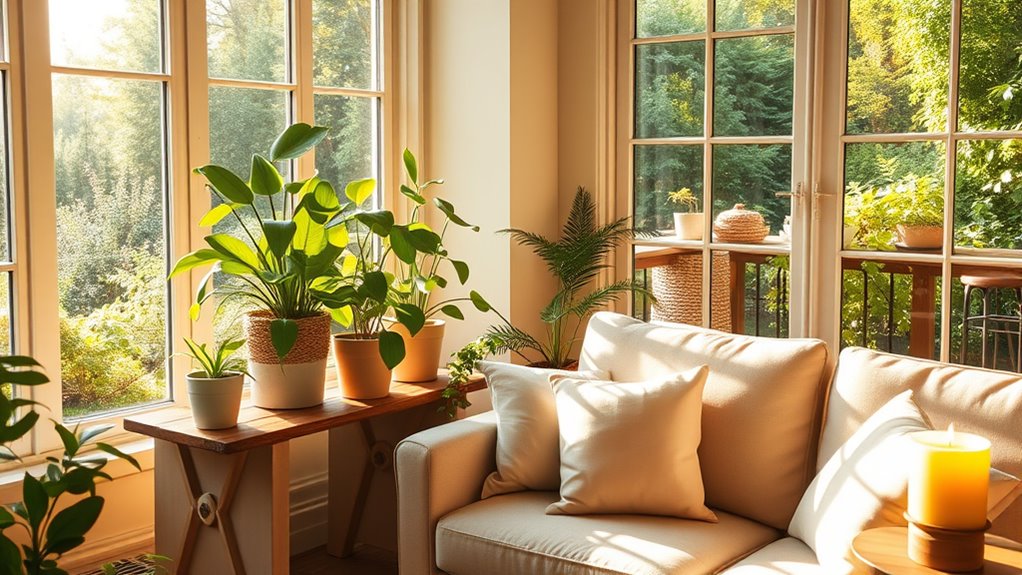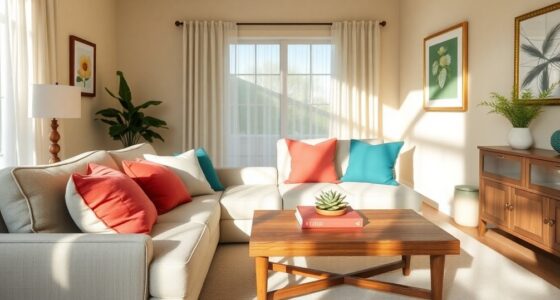To create a mood-boosting home, maximize natural light by opening curtains and using mirrors to reflect sunlight. Incorporate natural textures and plants for a calming vibe, and choose colors like green, blue, or soft neutrals to promote relaxation. Use layered, warm lighting and add cozy textures like cushions and rugs. Keep your space organized and clutter-free, and use calming scents like lavender or citrus to lift your mood. For more ideas, explore ways to enhance your environment further.
Key Takeaways
- Maximize natural light with open blinds, mirrors, and clean windows to enhance mood and circadian rhythms.
- Incorporate natural textures, indoor plants, and calming colors to create a tranquil, biophilic environment.
- Add soft, cozy textiles and personalize spaces with meaningful decor for comfort and emotional well-being.
- Use layered lighting, ambient sounds, and aromatherapy to craft a relaxing, balanced atmosphere.
- Maintain organization and reduce noise with proper storage, soundproofing, and calming scents to promote mental clarity.
Maximize Natural Light and Brightness
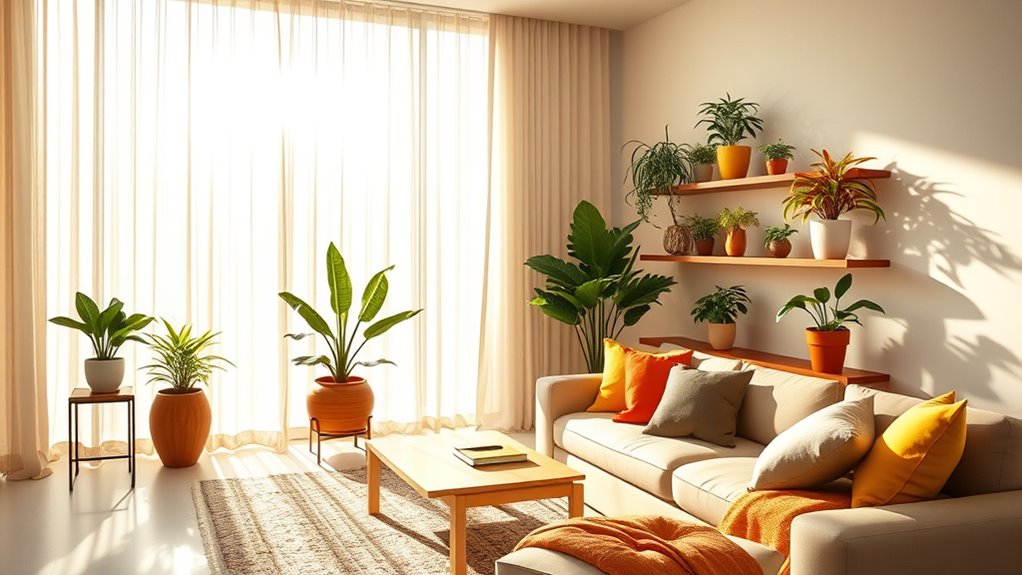
Maximizing natural light in your home starts with simple daily habits. Open your blinds and curtains each morning to let in sunlight, boosting brightness and helping regulate your circadian rhythm. Incorporating celebrity interior trends can inspire stylish ways to enhance your space with light and design. Additionally, choosing energy-efficient windows can improve insulation while allowing more natural light to enter, creating a brighter and more comfortable environment.
During the day, face windows to maximize exposure to natural light, which can lift your mood and increase vitamin D levels. Hang mirrors opposite windows to reflect outdoor sunlight into darker corners, amplifying brightness without extra windows.
Use light, transparent window treatments to allow more daylight in while maintaining privacy. Keep your windows clean to ensure maximum sunlight enters your space. Incorporating reflective surfaces and natural light optimization techniques can further enhance the overall brightness and ambiance of your home.
Incorporate Natural Elements and Biophilic Design
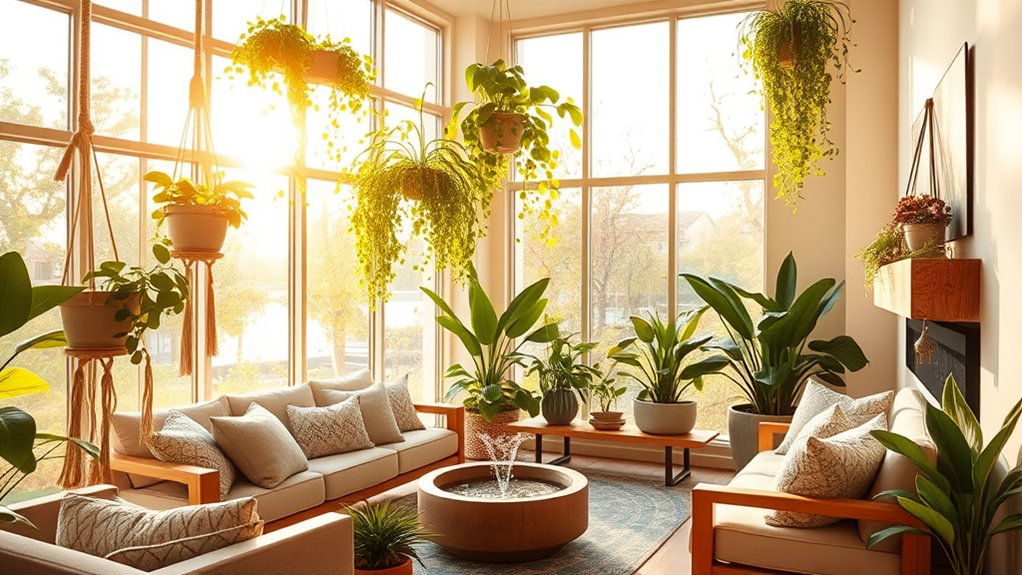
Bringing natural elements into your home can markedly boost your mood and sense of calm. Incorporate natural textures like wood, stone, and fibers to evoke tranquility and strengthen your connection to nature. Natural materials can also help create a more authentic and inviting atmosphere. Using biophilic design principles, which mimic natural environments, can reduce stress and promote well-being. Adding plants, water features, or views of greenery activates the brain’s safety responses, creating a soothing atmosphere. Natural materials in your indoor environments help lower blood pressure and improve overall mood. Incorporating diverse plant designs can further enhance your space’s aesthetic appeal and emotional benefits. The use of digital platforms for collaboration in virtual environments can also support creative and collaborative efforts when designing your space. Provenza’s Travertine tiles, with their natural tones and textures, exemplify how integrating authentic materials enhances harmony and stress reduction. Selecting the right paint finishes can also influence the calming effect of your space, contributing to a more tranquil environment. Additionally, skincare ingredients like hyaluronic acid and collagen can complement this natural approach by supporting your skin’s health and vitality.
Optimize Lighting Strategies for Mood and Atmosphere
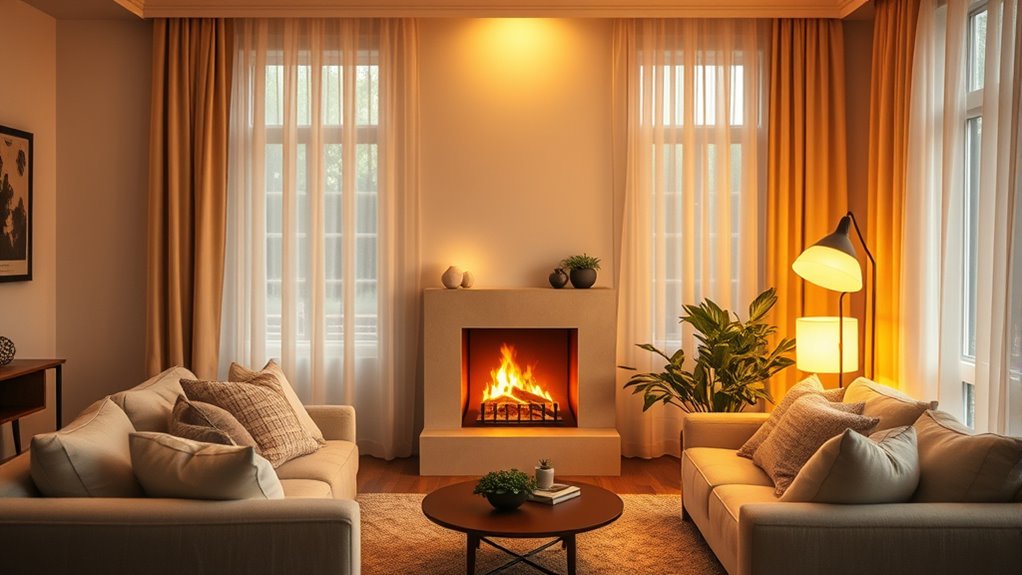
To create a welcoming and uplifting space, you should layer multiple light sources to add depth and flexibility.
Using dimmable and warm lights helps set a cozy mood and reduces eye strain.
Adjusting your lighting throughout the day keeps the atmosphere aligned with your natural rhythms.
This thoughtful approach allows you to effortlessly shift from energizing mornings to relaxing evenings.
Layer Multiple Light Sources
Layering multiple light sources is an effective way to create a flexible and inviting home environment. With layered lighting, you combine ambient light, task lighting, and accent lighting to craft the perfect mood. Using dimmable fixtures allows you to adjust brightness levels easily, enhancing mood and reducing eye strain. Incorporate light temperatures—warm tones for coziness and cool tones for alertness—to influence emotional responses and set the right atmosphere. This approach also offers versatility, letting you switch from bright, energizing spaces to calm, relaxing zones with ease. Well-designed layered lighting not only boosts mood but also improves mental clarity, making your home feel more comfortable and safe. sound design principles, such as ambient sounds that complement your lighting, can further enhance the atmosphere and emotional impact of your space. Additionally, understanding lighting techniques can help you create more dynamic and personalized environments. It’s a simple way to tailor your environment to your needs and preferences. For example, consulting resources like sleep solutions for new parents can help optimize your home environment for better rest and well-being. Incorporating lighting adjustments based on activity or time of day can also maximize the benefits of your layered lighting setup. Recognizing the importance of dream symbolism can inspire creative ways to design spaces that evoke specific feelings or memories, enriching your home ambiance.
Use Dimmable and Warm Lights
Using dimmable and warm lights enhances the flexibility of your home’s lighting setup, allowing you to tailor the atmosphere to your mood or activity. Dimmable lights let you adjust brightness levels, creating a calming or energizing ambiance when needed. Warm-toned bulbs around 2700 kelvin promote relaxation, foster intimacy, and help reduce eye strain, boosting emotional comfort. Incorporating these lights supports your circadian rhythms by mimicking natural light patterns, which can improve sleep quality and daytime mood. Additionally, understanding lighting control systems can inspire cozy, comforting environments that appeal to your senses and enhance relaxation. Warm, adjustable lighting also helps reduce stress and anxiety by making your space feel cozy and inviting. With dimmable and warm lights, you gain control over your environment, encouraging positive emotional responses and a more relaxed, mood-boosting home atmosphere. Choosing the right lighting fixtures can further enhance the overall ambiance and functionality of your space.
Adjust Lighting Throughout Day
Adjusting your lighting throughout the day can profoundly influence your mood and comfort. Start by maximizing natural light exposure each morning—open blinds and sit facing windows to boost alertness and support your circadian rhythm. Use adjustable, dimmable lighting to shift the ambiance as the day progresses, promoting energy or relaxation when needed. In the evening, incorporate warm-toned LED lights around 2700 kelvin to create a cozy atmosphere that encourages restful sleep and emotional comfort. Reflect outdoor light into darker spaces with strategically placed mirrors to enhance brightness without adding windows. To optimize your environment, consider the importance of lighting strategies in influencing mood and overall well-being. Employing appropriate lighting can further help you regulate your mood and create a balanced atmosphere. Shifting from bright, cool daytime lighting to softer, warmer tones as night approaches helps to regulate your mood and prepare your body for restful sleep. Additionally, integrating smart lighting systems can automate lighting adjustments, ensuring optimal conditions throughout the day.
Use Colors to Influence Emotions and Energy
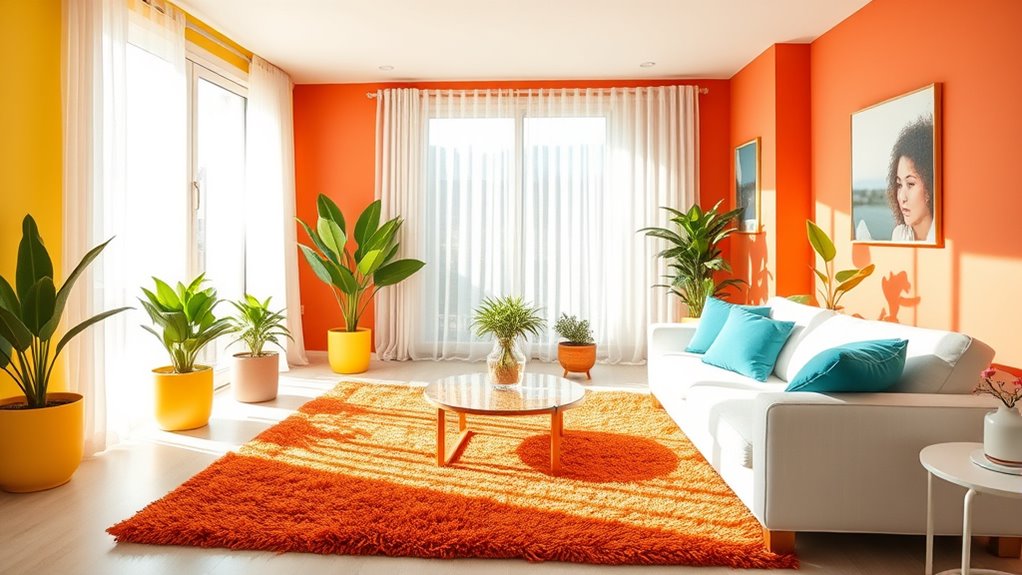
Colors have a powerful impact on your mood and energy levels, so choosing the right hues can transform your home environment. Soft, natural colors like pale greens, blues, and whites evoke calming feelings and support mental health by mimicking nature’s soothing effects. Less saturated hues reduce stress and promote mental clarity, making spaces feel more serene. Incorporating dynamic communication exercises can also improve emotional connection within the home, enhancing overall harmony. Bright colors such as yellow and orange boost happiness and creativity, energizing your environment. Using color psychology, you can select shades like sage green in a home office to enhance focus and productivity. Incorporate vibrant accent colors strategically to uplift your mood without overwhelming the space’s calming vibe. Additionally, understanding the psychological effects of color can help you choose the most beneficial hues for each room to optimize your emotional well-being. Recognizing the personality traits associated with different colors can further refine your choices to better suit your personal preferences and needs.
Enhance Your Space With Aromatherapy and Scents
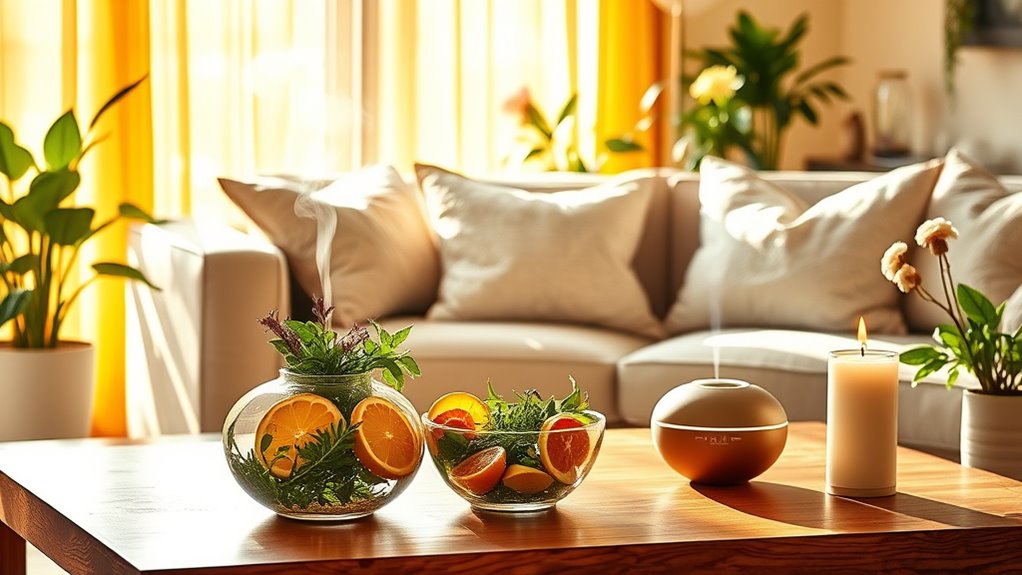
Incorporating aromatherapy and thoughtfully chosen scents can substantially enhance the mood and atmosphere of your home. Using essential oils like lemon, lavender, peppermint, or vanilla can boost relaxation, alertness, and overall mood. Diffusing lemon essential oil in your workspace may improve cognitive performance, while lavender helps promote restful sleep. Scents that evoke positive memories, such as citrus or vanilla, create an uplifting environment. Consider the following options:
| Aromatherapy Benefits | Scents to Use |
|---|---|
| Boosts alertness | Peppermint, rosemary |
| Promotes relaxation | Lavender, chamomile |
| Elevates mood | Citrus, vanilla |
Declutter and Organize for Mental Clarity
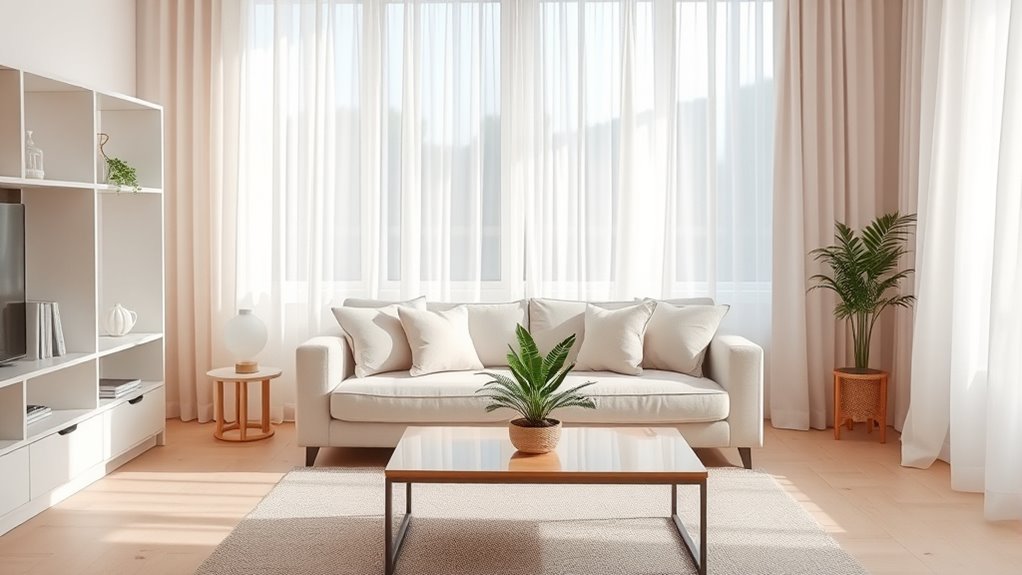
Decluttering your space can substantially boost your mental clarity and reduce stress. When you minimize visual stimuli, sensory overload decreases, helping you feel calmer and more focused.
Organization plays a key role in fostering a sense of control, which promotes emotional stability and clarity of mind. Removing unnecessary items creates a cleaner environment that supports better focus and mood.
To keep your space orderly, consider implementing designated storage solutions that prevent clutter buildup over time. This not only enhances relaxation but can also improve sleep quality.
- Simplify surfaces to reduce visual chaos
- Use storage bins or shelves to maintain order
- Regularly reassess belongings to keep clutter in check
Create a Cozy, Personalized Environment
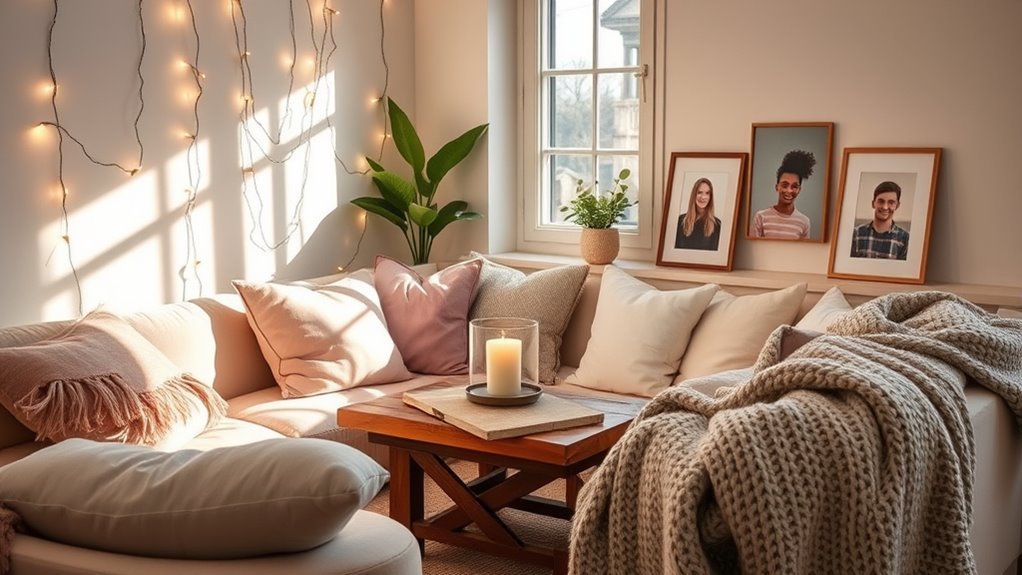
Once you’ve cleared away unnecessary clutter, you can focus on making your space truly feel like your own sanctuary. To create a cozy, personalized environment, add soft textures such as plush blankets, cushions, and rugs that invite comfort and warmth.
Incorporate meaningful photos, artwork, or objects that reflect your taste and memories, making the space feel uniquely yours. Choose warm, inviting colors like earthy tones, gentle greens, or warm neutrals to foster a calming atmosphere.
Including low-maintenance indoor plants, such as succulents or snake plants, boosts tranquility and air quality. Arrange your furniture to create cozy nooks or relaxation zones, making your environment feel safe, inviting, and perfect for unwinding and rejuvenation.
Manage Noise and Elevate Ambiance
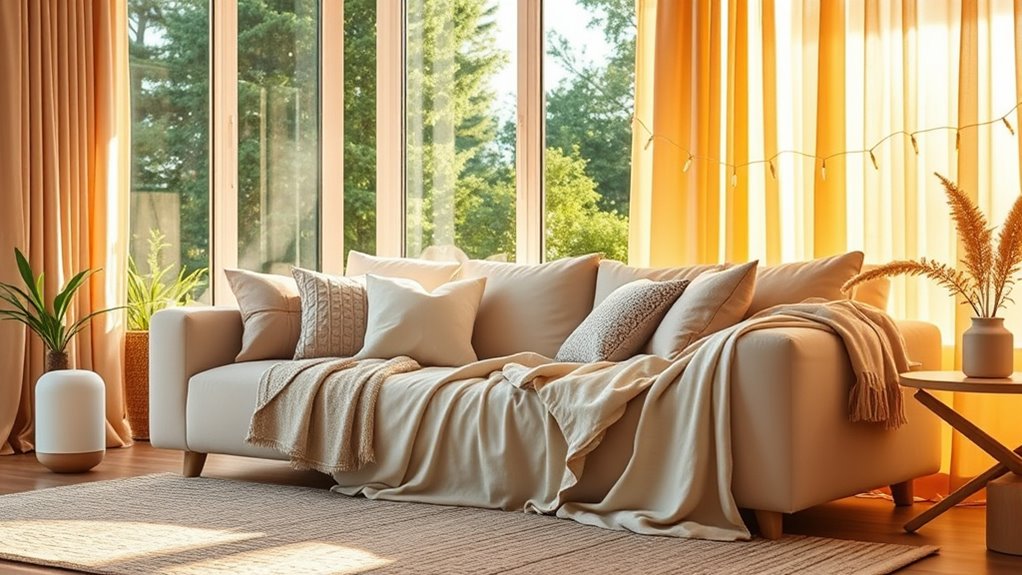
You can create a calmer home by using soundproofing techniques like adding carpets and curtains to absorb noise. Noise-canceling headphones also help block out distractions, making your space more peaceful.
Personal touches like soothing artwork and decor further enhance your mood and sense of comfort.
Soundproofing Techniques for Calm
Creating a peaceful home environment often starts with managing noise effectively. Soundproofing helps you craft a calming environment by reducing disruptive sounds and enhancing ambient sound quality.
You can install acoustic panels or foam tiles on walls to cut reverberation by up to 80%, making your space quieter and more relaxing. Heavy curtains or soundproof window inserts block external noise, decreasing sound levels by as much as 50%. Incorporating soft furnishings like plush rugs and upholstered furniture absorbs sound, minimizing ambient noise.
Sealing gaps around doors and windows with door sweeps further prevents noise leakage. Additionally, using white noise machines or calming ambient sound systems masks intrusive sounds, helping you relax and focus.
These soundproofing techniques elevate your home’s ambiance and promote tranquility.
Personalize With Soothing Decor
Personalizing your space with soothing decor not only reflects your style but also enhances its calming atmosphere. Adding personal touches, like favorite colors or cherished memorabilia, creates a sense of emotional security and ownership.
Incorporate calming colors to promote relaxation and tranquility throughout your home. Soft textiles, such as plush cushions and cozy blankets, help absorb ambient noise, making your space quieter and more peaceful.
Using sound-absorbing materials like curtains, rugs, and wall panels can further reduce ambient noise, lowering stress levels. Thoughtfully selected decor that speaks to your personality elevates the overall ambiance, fostering a calming and uplifting environment.
Frequently Asked Questions
How Can I Improve Air Quality Naturally in My Home?
You can improve your home’s air quality naturally by regularly opening windows to air out spaces and let fresh air in. Incorporate houseplants like snake plants or pothos, which naturally filter toxins. Avoid synthetic fragrances and opt for natural cleaning products.
Use a humidifier to maintain ideal moisture levels, and ensure proper ventilation in areas like the kitchen and bathroom. These simple steps help purify your air and boost your well-being.
What Are the Best Plants for Low-Light Indoor Environments?
You want the best plants for low-light indoor environments, and choosing the right ones can make a big difference. Look for plants like snake plants, pothos, and ZZ plants—they thrive in dim spaces, are easy to care for, and improve your home’s air quality.
These plants not only add greenery but also help create a calming, vibrant atmosphere, making your space healthier and more inviting.
How Do I Choose the Right Lighting Fixtures for Mood Enhancement?
When choosing lighting fixtures for mood enhancement, you should focus on adjustable options like dimmable lights or layered lighting.
Think about warm tones to create a cozy atmosphere and incorporate different light sources such as lamps, fairy lights, or wall sconces.
Consider your room’s size and purpose, ensuring the lighting is soft and inviting.
You’ll want to balance brightness and warmth to foster a relaxing, uplifting space.
Which Colors Are Most Effective for Reducing Stress at Home?
You want to know which colors help reduce stress at home. Soft, calming hues like light blue, gentle green, and muted lavender are your best options. These colors promote relaxation and tranquility, making your space feel peaceful.
Avoid bright, intense shades that can be stimulating. Instead, opt for these soothing tones on walls, décor, or accents to create a calming atmosphere that eases your stress and enhances your mood.
How Can I Personalize My Space to Boost Happiness?
You can personalize your space to boost happiness by adding items that reflect your personality and passions, like artwork, photos, or souvenirs. Incorporate your favorite colors and textures to create a cozy, inviting atmosphere.
Arrange your furniture to promote flow and comfort, and include plants or natural elements for freshness. Remember, your space should make you feel good—so trust your instincts and tailor it to what makes you happy.
Conclusion
Creating a mood-boosting home isn’t just about looks—it’s about feeling good in your space. By maximizing natural light, adding personal touches, and managing clutter, you set the stage for happiness. Remember, a tidy home is a tidy mind, so take small steps to improve your environment daily. When you create a space that nurtures you, you’re more likely to thrive—after all, home is where the heart is.
